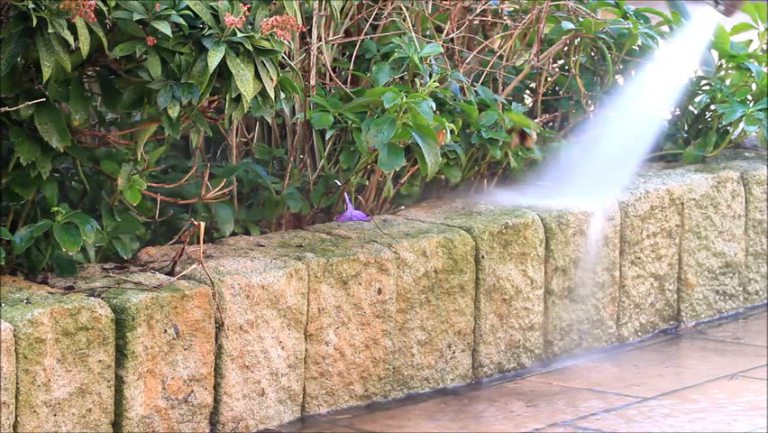Natural weathering of stone is inevitable, but some types have a structure that makes them more durable than others.
There are three major causes of deterioration in natural stone; pollutants, frost and crystallization of soluble salts. Water penetration is the main instigator of decay, and structure is the most important factor influencing the ability of stone to resist decay processes.
Stone Rejuvenation

Step 1
Assess the surface of your natural stone patio to determine its type of stains. The cleaning methods you use will depend on the type of stains present.
Step 2
Sweep entire surface, removing loose sand, leaves, gravel and other debris. Sweep the entire surface in one direction horizontally, and sweep again vertically. That technique ensures you remove dirt that falls in the cracks between the stones
Step 3
Spray the surface of the stones with clean water from a hose. The water will remove surface dust and dirt that remains after sweeping.
Step 4
Remove grease stains, by scrubbing them with a gentle, household, liquid detergent, such as dish soap. Squirt the detergent over a stain on the stone, and scrub the stone with a scrub brush. Rinse the area with water from the hose to remove the grease stain and cleaner.
If it fails then try removing the stain with an ammonia solution made with 50 ml of ammonia mixed with 1.5Ltr of water. Rinse the stone surface completely between each cleaning attempt to prevent chemicals from mixing.
Step 5
Clean biological stains caused by moss, mildew and/or lichen by mixing 1/2 cup of household bleach with 1.5 Ltr of water. Scrub the area with the diluted bleach solution. It will clean the stains and kill the organisms that can make them return. Mop up the excess bleach solution with clean clothes or rags, and rinse the stains with clear water.
Consolidation

In order to consolidate suspended particles of the mineral substrate, Waterrepellent’s Stone Consolidator is preferably applied undiluted to the dry and cleaned material. Stone Consolidator reacts with moisture to form a polymeric siliceous network. The network re-embeds the decomposed mineral particles and thus stabilizes and fixes the stone permanently.
The impregnating process with Stone Consolidator can be re-done after a reaction time of 3 weeks after the initial treatment.
The effect of consolidation with Stone Consolidator has fully developed after 2 – 3 weeks.
Protection

Protection of stones form environmental hazard can be done using Stone Sealers, depending upon desired properties of stones selection of sealers are done.
Hard Stone material such as Marble, Granite, etc. has least porosity hence they need to be treated with solvent base product such as Water Repellent SSB19, Stone Sealer 15 & Stone Sealer 19.
Soft stones such as limestone, mint stone, etc. has huge porosity hence they can be treated with water base products such as Stone Sealer-(W) -15, Water-repellent TR-WR-S500, & Water-repellent TR-WR-813.
To protect stone form vandalism by graffiti apply TR- Anti- graffiti coat which decreased adhesion of aerosol paints, gums, spitting stains, etc. also protects stone form natural where and tare due to climatic changes.
Ecstatic Value to Stone

Stones in natural from are always preferred but adding an ecstatic value to it gives a different charm to it. Super Gloss is used by many stone architect to give gloss to rough stone or stone art to enhance its beauty with gloss and color deepening effect.
For More information about product visit our website: www.waterrepellent.in or mail us: info@waterrepellent.in
About Blog Writer:
Er. Amit D. Vasa owns a brand Waterrepellent which develops Water Repellent coatings for construction industries and specialty products.
